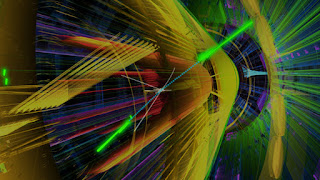 |
| The photons are indicated by the clusters of energy shown in green. (Courtesy: CERN) |
Topics: Large Hadron Collider, LHC, Particle Physics, Theoretical Physics
Last year, the LHC's ATLAS and CMS experiments both reported a small "bump" in their data that denoted an excess of photon pairs with a combined mass of around 750 GeV. As this unexpected bump could be the first hint of a new massive particle that is not predicted by the Standard Model of particle physics, the data generated hundreds of theory papers that attempt to explain the signal. Of these, four different theoretical explanations – a particle predicted by a lesser-known version of supersymmetry; a particle linked to a new kind of strong nuclear force; a Higgs-like boson; and a decay product from other very heavy particles – have been selected for publication in this week's issue of Physical Review Letters.
Physics World: Theorizing about the LHC's 750 GeV bump, Edwin Cartlidge
Comments